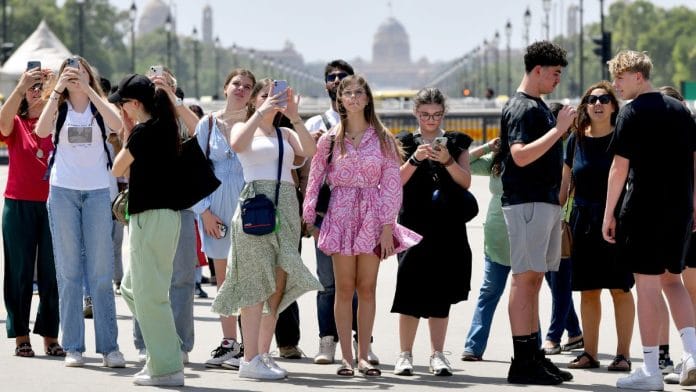New Delhi: The United States has expanded on a Level 2 travel advisory for India, urging American citizens to “exercise increased caution” due to heightened risks of crime and terrorism across the country. It also included new restrictions, requiring US government employees to seek permission before travelling to parts of India.
The advisory, updated by the US Embassy last week outlined growing concerns over violent crime—including sexual assaults at tourist destinations—and the potential for terrorist attacks in both urban and rural areas.
The advisory highlighted rape as one of the “fastest-growing crimes in India” and warned that violent incidents, including assaults targeting tourists, remain a serious concern. “Do not travel alone, especially if you are a woman,” the advisory says.
The US government also said terrorist attacks could occur with little or no warning and often target heavily populated public spaces such as transportation hubs, marketplaces, and government buildings.
While the travel advisory covers the entire country, it includes specific warnings for regions considered particularly dangerous. The US government explicitly cautioned its citizens against traveling to certain zones known for insurgent activity and regions with ongoing civil unrest.
According to the advisory, among the most at-risk areas are the Union Territory of Jammu and Kashmir, the India-Pakistan border, and several parts of central and eastern India affected by Maoist insurgency.
A travel advisory is a notice issued by the US Department of State to inform American citizens about all the safety risks of travelling to foreign countries.
The advisories are updated annually for Level 1 and 2 countries, and at least every six months for Levels 3 and 4. These advisories use a color-coded system: Level 1 (blue) means normal precautions, Level 2 (yellow) indicates increased caution, Level 3 (orange) advises reconsidering travel, and Level 4 (red) warns against all travel.
Advisory levels are based on risk indicators such as crime, terrorism, civil unrest, health concerns, natural disasters, and events like elections or large gatherings. Additional concerns may include kidnapping, wrongful detention, or other safety threats unique to specific regions.
According to Christopher Clary, an associate professor of Political Science, University at Albany, while India has always been on Level 2, “Previously the advisory was largely concerned with risks of terrorism and insurgency, especially in certain states. Women were encouraged not to travel alone. Those concerns about violence against women have been foregrounded in most recent update.”
Also Read: India is re-hyphenating itself with Pakistan all over again. It needs a new 3D strategy
Regions out of bounds: LoC, Northeast, central India
In addition to general security risks, the advisory includes detailed restrictions for US government employees in India.
Officials are now required to seek special authorisation before traveling to regions such as eastern Maharashtra, northern Telangana, and western West Bengal due to heightened terrorist threats in those areas. Approval is also necessary for travel to most districts in Bihar, Jharkhand, Chhattisgarh, Odisha, and Meghalaya, excluding the capital cities.
The advisory also warns American travelers against carrying satellite phones or GPS devices into India. Possession of such equipment is considered illegal under Indian law and could result in a fine of up to $200,000 or a prison sentence of up to three years.
Among the most severe warnings is the advisory against travel to Jammu and Kashmir—excluding eastern Ladakh and its capital, Leh—due to the persistent threat of terrorism and the risk of civil unrest. The advisory cites incidents of violence in popular tourist destinations within Kashmir, including Srinagar, Gulmarg, and Pahalgam. The US also warns that travel to areas near the Line of Control (LOC) between India and Pakistan is strictly prohibited for foreign tourists under Indian government regulations.
The India-Pakistan border is also designated as a “do not travel” zone. The advisory notes the presence of heavy military forces on both sides and emphasises that the only authorised crossing point for non-citizens is the Attari-Wagah border in Punjab. It warns that US citizens must obtain a Pakistani visa in their home country before attempting to cross into Pakistan from India, unless they already reside in India.
The US also advises against crossing the India-Nepal border by land, citing a pattern of immigration-related detentions and fines imposed on US citizens. According to the embassy, electronic visas are not accepted at land border crossings into India, and even travelers holding valid physical visas have faced arrest and prolonged legal proceedings due to misunderstandings about visa rules.
In the northeastern state of Manipur, the US government warns against all travel due to ongoing ethnic violence, attacks on Indian government institutions, and widespread displacement of communities. American officials stationed in India must obtain prior approval before entering Manipur.
Although the advisory stops short of banning travel to the broader Northeast, it advises travellers to reconsider plans to visit regions where insurgent groups have historically carried out attacks, including bombings on buses, rail infrastructure, and marketplaces. While there have been no recent incidents in Assam, Nagaland, Arunachal Pradesh, Mizoram, Sikkim, or Tripura, US personnel must obtain approval before traveling to Sikkim and Arunachal Pradesh or outside the capital cities in Assam, Nagaland, Mizoram, Meghalaya, and Tripura.
The travel advisory concludes by encouraging all US citizens to carefully review the full India Country Security Report published by the Overseas Security Advisory Council (OSAC), prepare an emergency action plan, and ensure compliance with all Indian immigration laws.
The US government emphasised that while it maintains consular services across major Indian cities, its ability to provide emergency support in rural or high-risk areas remains limited.
Correction: An earlier version of this report incorrectly suggested that India was previously at ‘Level 1’. This has been updated to reflect that India was always in ‘Level 2’.
(Edited by Sanya Mathur)
Also Read: India-Pakistan terms of engagement: H-word, M-word & the Trump hyphenation






